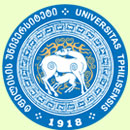
|
 |
 |


 |
DEPARTMENT OF PLASMA PHYSICS
|
A Brief History of the Establishment
of the Department of Plasma Physics at the Institute
|
|
|
At the institute, founded by the efforts of Elevter Andronikashvili at the end of 1950, on his initiative and direct participation,
a number of departments were created, working in topical areas of physics.
|
|
|
In 1956, when important results in the field of plasma physics were declassified as "top secret" and they became public knowledge
both in the Soviet Union and in Western Europeand the United States of America, it became clear that research in this direction
had great perspectives in physics in general, and namely in solving the problem of controlled thermonuclear fusion. Proceeding
from this, Elevter Andronikashvili, realizing the need and prospects for the development of plasma physics at the institute, in 1958
from the Kharkov Institute of Physics and Technology invited a young promising Georgian plasma physicist, a student of the
famous Soviet physicist Alexander Akhiezer, candidate of physical and mathematical sciences, Nodar Tsintsadze.
|
|
|
In 1958-1960, on the initiative and under the leadership of Nodar Tsintsadze, the first group of physicists working in the direction
of plasma physics was founded at the institute, on the basis of which the Department of Plasma Physics was officially established in
December 1960. The first so-called "constituent" composition was as follows: Theorists - Nodar Tsintsadze, Jumber
Lominadze, Avtandil Pataraia, Nikoloz Giorgadze, Tsiala Loladze, Ramaz Ramazashvili, Vladimir (Vova) Petviashvili;
Experimenters - Edward Barkhudarov, Besik (Busa) Zhvania, Rema Antonova, Archil Khantadze, George (Paso) Rostomashvili,
Merab Taktakishvili, Sulkhan Nanobashvili.
|
|
|
Since its foundation, intensive scientific work has been carried out both in theoretical and experimental directions.
|
|
|
The main subject of theoretical research at the first stage was the decay instability of electromagnetic waves in turbulent plasma
and the possibility of using it to heat the plasma. As for experimental research, at the first stage, an original high-voltage induction
discharge system was built, in which the cumulative effects resulting from the collision of dense plasma bunches moving at
different velocities were studied.
|
|
|
On the part of Elevter Andronikashvili and Nodar Tsintsadze, great attention has been paid to sending employees and successful
students of Tbilisi State University to the leading centers of plasma physics of the Soviet Union for postgraduate specialization and
PhD studies. This undoubtedly contributed to the fact that for many years the Department of Plasma Physics was staffed with
highly qualified theorists and experimenters.
|
|
|
After completing postgraduate studies and defending candidate dissertations, a large group of both theorists (R. Ramazashvili,
V. Petviashvili, D. Tskhakaia, G. Machabeli. G. Suramlishvili) and experimenters (T. Chelidze, S. Nanobashvili,
N. Kervalishvili)
returned to the department from the second half of the 60s and during the 70s. Successful graduates of Tbilisi State University,
theorists (V. Berezhiani, E. Khirseli, T. Tavdgiridze) and experimenters (G. Gelashvili, V. Chichi-
nadze, V. Berezovsky) also came to
the Institute. This significantly intensified the scientific work at the department, and this group became one of the leading
research teams of the institute.
|
|
|
In 1976, the first graduates of the Chair of Plasma Physics of the Faculty of Physics of Tbilisi State University, established by the
efforts of Nodar Tsintsadze and with the support of Elevter Andronikashvili (successful students in 1978 (G. Gogiashvili,
D. Razmadze, M. Mdivnishvili and G. Gumberidze), after completing their diploma theses in the Department of Plasma Physics,
were enrolled in the staff of the department.In subsequent years, a number of successful students of the specialty of plasma physics
at Tbilisi State University became members of our department as well.
|
|
|
In 1970, on the initiative and efforts of Nodar Tsintsadze, Institute of Physics founded a two-week school-conference in plasma
physics, which was held every two years with the participation of foreign scientists. At first it had a significance within the Soviet
Union, and soon became of international status. In the period 1970-1990, a total of ten such schools were held. This school-
conference, due to its high scientific level and real effort to improve the skills of young researchers, has become of great
international prestige in the field of plasma physics. Of course, in addition to the scientific achievements of the Department of
Plasma Physics, this also contributed to the high international prestige and recognition of the department.
|
|
|
One more important point should be noted - in 1976, with the efforts of the leading theorist of plasma physics of the institute
Jumber Lominadze and with the support of the director of the Abastumani Astrophysical Observatory, Academician Evgeny
Kharadze, with the participation of Avtandil Pataraia and George Machabeli, the Department of Plasma Astrophysics was
founded at the Abastumani Astrophysical Observatory, which continues its successful work to this day and is one of the important
scientific teams of the observatory.
|
|
|
We can say that this was the end of the first and very important stage in the creation of the Department of Plasma Physics.
|
|
|
As for the scientific work after the stage of establishing the Department of Plasma Physics, it is specifically presented on the website
of the department below.
|
 |
|





